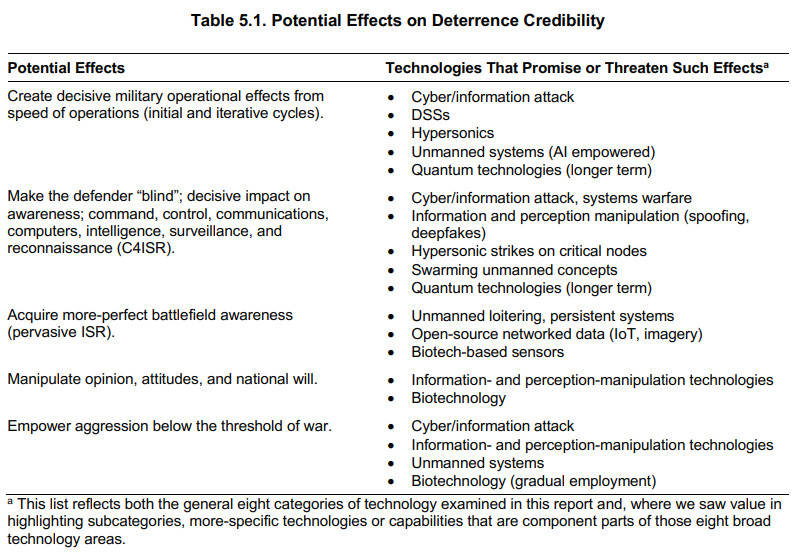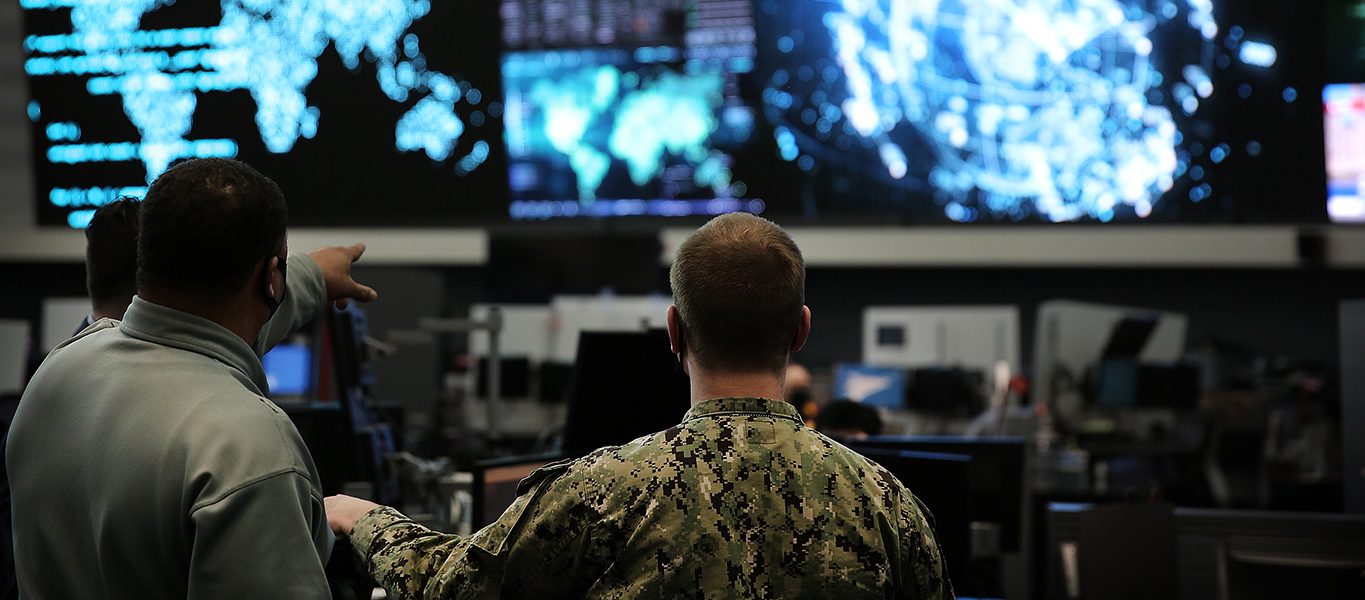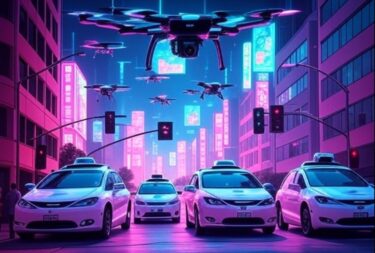The so-called fourth industrial revolution will fundamentally “change the character of warfare” with advanced influence campaigns, information manipulation, cyberattacks on critical infrastructure, electromagnetic capabilities, and a whole lot more, according to a recent RAND Corporation report.
“A suite of emerging technologies, many of them centered on the processing and manipulation of information and information networks, have the potential to generate revolutionary effects that some have termed a ‘fourth industrial revolution‘” — Disrupting Deterrence, RAND, 2022
The 85-page report, “Disrupting Deterrence: Examining the Effects of Technologies on Strategic Deterrence in the 21st Century,” highlights the use of interrelated technologies emerging from the fourth industrial revolution (4IR) as having potential “revolutionary effects” on “the processing and manipulation of information and information networks.”
According to the report, “A suite of emerging technologies, many of them centered on the processing and manipulation of information and information networks, have the potential to generate revolutionary effects that some have termed a ‘fourth industrial revolution.’”
To get up-to-speed on the emerging technologies while conducting a “review of analyses and rosters of technologies still in development,” RAND researchers consulted with the World Economic Forum (WEF) and the National Intelligence Council’s Global Trends series.
“The difference of this fourth industrial revolution is it doesn’t change what you are doing — it changes you” — Klaus Schwab on Charlie Rose, 2015
WEF founder Klaus Schwab, who literally wrote the book on “The Fourth Industrial Revolution,” considers the 4IR to be the technological driving force behind the unelected globalists’ great reset agenda to revamp all aspects of society and the global economy.
With its fusion of our physical, biological, and digital identities, Schwab has repeatedly stated that the fourth industrial revolution won’t just change what we are doing, but it will change who we are as people.
Now, the US Air Force-commissioned RAND report is suggesting that the 4IR will likely have a similar character-changing effect on warfare as Schwab says it will have on people.
According to the report, “The world may be on the verge of an inflection point, moving into what has been called the fourth industrial revolution, wherein a host of interrelated technologies—networks of smart devices, AI, advanced manufacturing techniques, quantum computing, DEWs [Directed Energy Weapons], and many more—will ‘fundamentally alter the way we live, work, and relate to one another,’ and, by extension, change the character of warfare.”
“We are at the beginning of a revolution that is fundamentally changing the way we live, work, and relate to one another” — Klaus Schwab, “The Fourth Industrial Revolution,” 2017
The “fundamentally alter the way we live, work, and relate to one another” quote cited in the report was taken directly from Schwab’s book, “The Fourth Industrial Revolution.”
When addressing the general public, Schwab and the WEF say 4IR technologies (and the great reset more broadly) will bring about greater inclusivity, resiliency, and equity.
However, when viewed through the lens of the military industrial complex, “fourth industrial revolution technologies [may] hold the potential to revolutionize the practice of warfare.”
Why?
The answers lie in the combination of technologies and attack surfaces that stretch from physical attacks to cyberattacks and information warfare that target both public and private infrastructures simultaneously.
“Information-and-perception-manipulation technologies cover a wide range of tools designed to distort the perception or beliefs of one individual or set of individuals for the purpose of achieving the perpetrator’s desired effect” — Disrupting Deterrence, RAND, 2022
In the service of information manipulation, 4IR tools can be deployed to distort people’s beliefs and perceptions.
According to the report, “Information-and-perception-manipulation technologies cover a wide range of tools designed to distort the perception or beliefs of one individual or set of individuals for the purpose of achieving the perpetrator’s desired effect.
“These technologies are generally enabled by AI and aspects of cyber and rely on processing large amounts of data. In the context of international security, this set of technologies enables adversaries to conduct advanced influence operations.”
“Aggressors are likely to make growing use of information-and-perception-manipulation technologies and techniques to create confusion, delay responses, divide alliances, and achieve other effects that could encourage wishful thinking or promote strategic miscalculations about war outcomes and thus undermine deterrence effectiveness” — Disrupting Deterrence, RAND, 2022
The report identifies four mechanisms through which information can be modified, with the goal of influencing or misleading targeted individuals or groups:
- Deepfakes: Making deepfakes is relatively cheap and easy, broadening the scope of individuals and organizations that can engage in this activity.
- Microtargeting: Generally used as an advertising tactic, microtargeting can also be used to make phishing attacks more effective by targeting only the most “valuable” (from the attacker’s perspective) individuals in a given company or organization.
- Machine Learning: One notable application of machine learning has been the development of bots, which are computer programs designed to emulate human behavior, particularly in online interactions.
- Spoofing: Refers to a form of interference that seeks to obscure or falsify the true source of information (often through impersonation) or replace a stream of information with false or malicious content.
The objectives of these techniques are to “create confusion, delay responses, divide alliances, and achieve other effects that could encourage wishful thinking or promote strategic miscalculations about war outcomes and thus undermine deterrence effectiveness.”
“Rather than merely attacking fielded military forces, an attacker could soon use information warfare (including attacks on space-based assets) […] to launch simultaneous blows against a defender’s entire military, economic, governmental, and social systems” — Disrupting Deterrence, RAND, 2022
In addition to providing tools for advanced information warfare, technologies coming out of the fourth industrial revolution are set to forever alter the future of warfare by expanding attack surfaces to include public and private infrastructures, both physical and digital, that can be targeted at the same time.
For example, there is an overlap between electromagnetic warfare (EW) and cyberwarfare that when combined, could cripple critical infrastructure.
“As the cyber landscape evolves,” the report says that “the convergence of cyber warfare and EW [Electromagnetic Warfare] would affect all areas of future military and civilian operations, including such applications as space operations and systems and position, navigation, and timing systems; wireless networks, 5G, IoT devices, and smart cities; critical infrastructure (such as power grids and reservoirs, banking and financial systems, and information transmission systems); military communication systems; and even UAVs and marine vehicles.”
What’s more, “Future developments in dual-use technologies, such as IoT, AI, and 5G, could create opportunities for adversaries to disrupt sensor-based critical infrastructure or create an environment for ‘ubiquitous ISR [intelligence, surveillance, and reconnaissance].’”

“There is an ever-increasing likelihood that knowledge, skills, and/or equipment in [the field of biotechnology] could be adapted for use as biological weapons” — Disrupting Deterrence, RAND, 2022
Tools coming out of the fourth industrial revolution can be used for good or ill, and they present both opportunities and risks, depending on the motives of those who wield them and the outcomes achieved.
Take biotechnology as an example used in the report.
“Although biotechnology is being used in many ways to combat debilitating diseases, reduce our environmental impact, and generally improve our lives and the planet,” the RAND report says, “this same technology has incredible potential for misuse, particularly because it is one of the fastest-growing commercial sectors.
“Thus, there is an ever-increasing likelihood that knowledge, skills, and/or equipment in this field could be adapted for use as biological weapons.”
On a more broader scale, 4IR technologies “promise to accelerate the digital and information technology transformation that has been ongoing for four decades and could create both new opportunities and new risks and vulnerabilities, from an insecure IoT to AI-driven automated decision-making to highly sophisticated techniques for manipulating human perception.”
It’s a matter of trust.
“Narratives shape our perceptions, which in turn form our realities and end up influencing our choices and actions” — The Great Narrative, Klaus Schwab & Thierry Malleret, 2022
The unelected globalists at the World Economic Forum openly support “manipulating” human perception in order to influence people’s decision-making. They call it “shaping.”
This is the entire basis of the WEF’s sequel to the great reset — the great narrative.
In their 2022 book, “The Great Narrative,” WEF founder Klaus Schwab and his writing partner Thierry Malleret explain why narratives are so important to their agenda:
“Narratives shape our perceptions, which in turn form our realities and end up influencing our choices and actions.”
With its technologically-advanced ability to shape perceptions, control narratives, and influence decision-making, the fourth industrial revolution plays a key role in the social engineering aspect of the great reset and great narrative agendas.
According to RAND, 4IR technologies “can have such effects as providing new ways of influencing decisionmakers and populations, increasing economic productivity that can be used to support military R&D or production, introducing new economic or societal vulnerabilities, creating new resource dependencies, or shifting the overall balance of power.”
The technological driving force behind the great reset is now changing the character of war, with the 4IR advancing information warfare, influence operations, and narrative control.
Perception is reality.
The military industrial complex and unelected globalists alike agree that the fourth industrial revolution holds the key to changing our perceptions, influencing our decisions, and altering our realities in ways that have never been technologically possible, until now.












